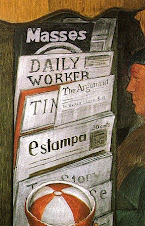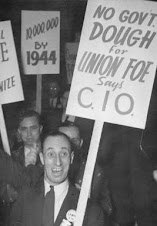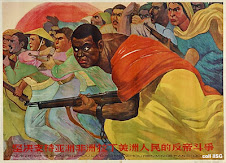By John Catalinotto
Published Jun 2, 2010 4:32 PM
Thai Prime Minister Abhisit Vejjajiva kept one promise. The military-backed Thai regime unleashed tanks and soldiers against thousands of “Red Shirts” occupying a posh business district of central Bangkok to clear the area of thousands of anti-dictatorship demonstrators. By May 20, the army had killed another 57 protesters in its offensive, more than 80 in total since March, and wounded 1,800.
Leaders of the opposition Red Shirts, also called the National United Front for Democracy Against Dictatorship, or UDD, surrendered to the regime on May 19 and pleaded with the demonstrators to disperse before the obviously superior firepower of the army. But thousands of the protesters defied their nominal leaders and set fire to luxury shopping malls, the stock exchange, government buildings, pro-military media centers and banks.
After tanks pushed rubber-tire barricades aside, some protesters began setting up new barricades. They fought running battles with soldiers before being finally driven out of the capital.
Some experienced observers of Thailand say they are surprised, even stunned, by the willingness of ordinary Thais to fight the way the Red Shirts did. “It has surprised everybody. It is highly disturbing,” says Richard Doner, associate professor of political science at Emory University and an expert on Southeast Asia. “Nobody would have expected this two weeks ago.” (PBS Newshour, May 19)
Few analysts agree with Prime Minister Abhisit that order had been restored as of May 20. They believe instead that the battle for Bangkok was only the first clash in a long struggle yet to unfold.
The questions that Marxist observers ask about Thailand at this point are: What is the class character of the government and of the opposition? What political leadership do the opposing sides have? What position does U.S. imperialism take? How would a revolutionary leadership behave in a similar situation?
Class character of “democracy” movement
There is no doubt that the Abhisit regime, installed by a military coup in 2006, represents the wealthy elite of Thailand and the top officer corps of the military. It also represents the interests of imperialist investors from the U.S., the European Union, Japan — the source for 7,000 enterprises operating in Thailand — and regional capitalist powers like Taiwan and Singapore.
The UDD, too, has been tied to big capital. Most of its leaders have thrown their support behind former Prime Minister Thaksin Shinawatra, a multibillionaire entrepreneur. Party leaders are from the educated and more privileged sectors. Both sides defended capitalism and private property and were willing to protect the interests of imperialist investors.
While Thaksin was prime minister, however, his government passed reforms reducing rural poverty and offering nearly free health care to the poorest urban and rural Thais.
Improvements for the poor drew popular support for Thaksin from farmers and workers, especially in the Northeast. They aroused even greater hostility among more privileged Thais. The latter worked with the top military officers to overthrow Thaksin in 2006. They mobilized against his party in the 2007 elections and, with the help of the courts, made sure it couldn’t form a government.
Frustrated by these anti-democratic maneuvers, the UDD called its rank-and-file supporters into central Bangkok in March, demanding the Abhisit government resign and call new elections. It apparently believed that mass pressure could wring concessions from the government and that the opposition could then win the election.
The masses of urban and rural poor came out in force and with enormous determination to back the UDD’s call. Many in the end were ready to risk their lives in the struggle against the dictatorship. They were taking a role in determining their fate. According to all reports, the vast majority of the Red Shirts’ ranks were workers and farmers.
U.S. imperialism in Thailand
The U.S. has been the dominant foreign political power in Thailand since World War II. The Pentagon has been especially close to the Thai military, using Thailand as its main airbase during the war against the Vietnamese, Lao and Cambodian peoples.
Washington’s silence after the mass slaughter shows that the U.S. ruling class much prefers a stable dictatorship in Thailand to an unstable situation with the masses in movement.
As with Honduras after last summer’s military coup and the rigged November election, Washington has made no complaints about the brutal Abhisit regime. Nor has there been much protest from pro-imperialist “human rights” organizations that are so vocal against Iran or socialist Cuba.
While the UDD leaders in Thailand have surrendered, the people have fought on, both in the streets and politically.
“We have been poor for hundreds of years, even thousands of years, and they are living in fancy resorts and mansions,” said Srirasa Reungrat, a woman from Chiang Rai in Thailand’s north, standing at the back of a temple in Bangkok on May 20. “They have been doing this to us for a long time.” (New York Times, May 20)
A revolutionary leadership in a situation like that would have the responsibility of standing with the masses in struggle, physically if possible, certainly politically. It would support the right of the masses to use whatever arms they have at hand to defend themselves, their movement and their demands.
Revolutionaries would also explore the possibilities of reaching out to the rank-and-file soldiers and the junior officers of the Thai armed forces, over one million strong, who are part volunteer and part conscript. There was evidence that these ranks — many of whom come from Red Shirt strongholds — were unhappy about being used against their class sisters and brothers. Just before ordering the final assault, the army killed the one general who had gone over to the Red Shirts.
Mass armed struggle and the possible collapse of the state power could open the door to an outcome far beyond just moving from an Abhisit to a Thaksin government. It could raise the possibility of a social revolution that would change the relations between rich and poor and between Thailand and world imperialism.
Since May 20, the army has pushed most in the mass movement — those not killed or wounded or singled out for arrest — out of Bangkok. Many returned to their home areas in the North and Northeast. Some reports indicate that activists in this movement are looking for political leadership different from the UDD and Thaksin, although he remains a popular political figure for the masses.
In an interview with Al-Jazeera aired on May 22, a Thai political activist in Chiang Mai, a Red Shirt stronghold, said that many of the Red Shirt members were looking for new leadership and would participate in an underground struggle against the Abhisit regime. Pictures on the wall of the political office were of Thaksin, the late Indian leader Mahatma Gandhi and the late revolutionary communist Che Guevara.
Ending her report, the Al-Jazeera journalist said that immediately following the interview this organizer went underground. In Thailand, the struggle continues.
Articles copyright 1995-2010 Workers World. Verbatim copying and distribution of this entire article is permitted in any medium without royalty provided this notice is preserved.
Subscribe to:
Post Comments (Atom)










































No comments:
Post a Comment